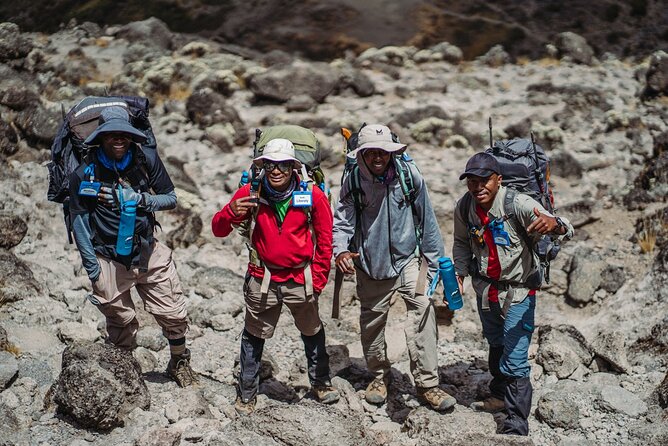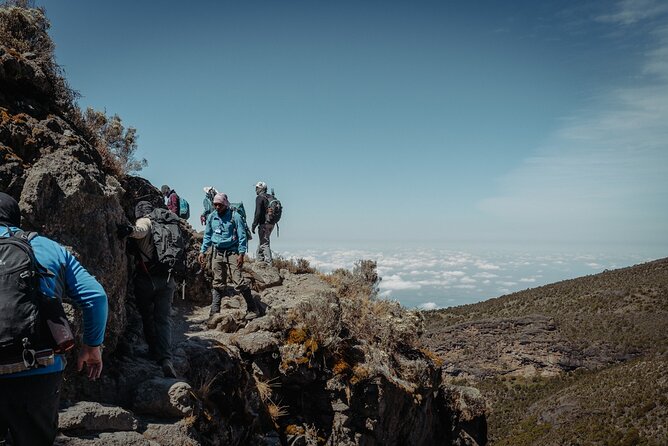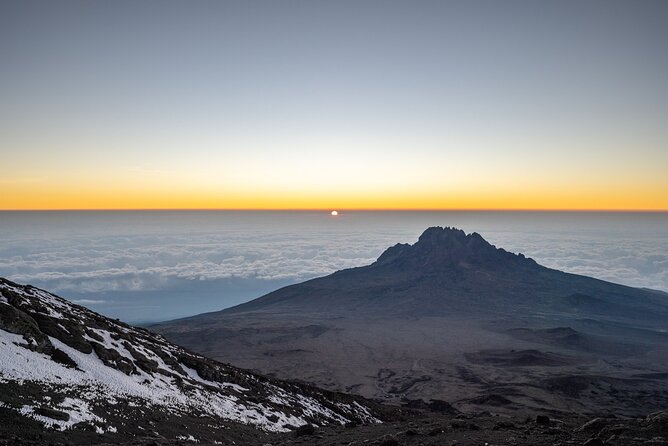Scaling the mighty Kilimanjaro through the Lemosho Route is a journey that captivates the imagination of adventure seekers worldwide. This 6-day trek offers a comprehensive experience, immersing trekkers in diverse landscapes and culminating in the conquest of Africa’s highest peak. With a focus on comfort, safety, and expert guidance, the itinerary is meticulously designed to maximize the chances of reaching the summit while prioritizing the well-being of the climbers. As trekkers embark on this exhilarating expedition, they’ll uncover the unique challenges and rewards that make Kilimanjaro a bucket-list destination for outdoor enthusiasts.
Key Points
- The Lemosho Route for climbing Kilimanjaro covers a distance of approximately 50 miles over 6 days, with average daily mileage ranging from 5 to 10 miles.
- The trek involves trekking through diverse landscapes, including lush rainforests, moorland, and alpine desert, with a significant elevation gain of around 3,000 feet on the first day.
- Accommodations include sturdy, weatherproof tents for two people, a dining tent, and well-maintained group equipment provided by the experienced crew.
- The tour operator ensures the safety and well-being of participants by providing certified Wilderness First Responder guides, comprehensive medical kits, and thorough medical checks before the climb.
- The pricing for the Kilimanjaro Lemosho Route (6-Day) climb is based on group size, with various payment options and a clear cancellation and refund policy.
Itinerary and Mileage
The 6-day Kilimanjaro climb via the Lemosho Route covers a total distance of approximately 50 miles (80 kilometers), with an average daily mileage ranging from 5 to 10 miles (8 to 16 kilometers).
On the first day, climbers will trek through lush rainforests, gaining around 3,000 feet (900 meters) in elevation.
The next few days involve gradual ascents through moorland and alpine desert landscapes, with the fourth day being the longest at around 10 miles (16 kilometers).
The final push to the summit on the fifth day covers about 5 miles (8 kilometers), culminating in the 19,341-foot (5,895-meter) peak of Uhuru.
The descent on the sixth day is approximately 7 miles (11 kilometers) back to the starting point.
You can also read our reviews of more tours and experiences in Moshi.
Accommodations and Facilities

On Kilimanjaro, climbers will bed down in sturdy, weatherproof tents provided by the outfitter, with two persons sharing each tent during the expedition. These tents offer a comfortable and reliable shelter amidst the ever-changing mountain conditions.
Along With the tents, the climbing crew will set up a dining tent, where meals are prepared and served. Participants will also be provided with sleeping pads, ensuring a good night’s rest between the physically demanding days.
The group equipment, including the tents and dining setup, is maintained by the experienced crew to ensure a smooth and enjoyable trekking experience. With these well-appointed accommodations, climbers can focus on their ascent of the mighty Kilimanjaro.
Gear and Equipment

When embarking on a Kilimanjaro climb, participants must ensure they’ve the appropriate gear and equipment to withstand the challenging, ever-changing conditions of the mountain.
Proper clothing, footwear, and accessories are crucial for a safe and comfortable trek, as the temperature can fluctuate dramatically from the base to the summit. Outfitters typically provide a comprehensive packing list to guide climbers in selecting the necessary items, which may include base layers, insulating jackets, waterproof shells, sturdy hiking boots, and trekking poles.
Plus, personal items such as headlamps, water bottles, and sun protection are essential for the journey. By meticulously preparing their gear, climbers can focus on the physical and mental demands of the ascent, maximizing their chances of reaching the top of Africa’s highest peak.
Dietary Options and Hydration
Alongside the physical demands of a Kilimanjaro trek, participants must also pay close attention to their dietary needs and hydration levels to ensure a successful and comfortable climb.
The tour operator provides three meals per day, with various dietary options to accommodate vegetarians, vegans, and those with food allergies or intolerances.
Staying hydrated is crucial, and hikers are encouraged to drink plenty of water, tea, coffee, and juices throughout the day. The crew closely monitors hikers’ fluid intake and provides regular reminders to drink.
Proper nutrition and hydration help maintain energy levels, prevent altitude sickness, and ensure a more enjoyable overall experience on the mountain.
Safety and Medical Considerations
The tour operator places a strong emphasis on safety and medical preparedness to ensure a secure and enjoyable Kilimanjaro experience for all participants.
Certified Wilderness First Responder guides lead the climbs, providing expert medical care if needed. They also carry oxygen tanks and comprehensive medical kits to address any health issues that may arise during the trek.
Plus, the operator conducts thorough medical checks before the climb and reserves the right to deny participation for those with serious health conditions. The focus on safety is further evidenced by the exclusion of those with back problems, pregnancy, or other serious medical concerns from the recommended participants.
Guides and Support Crew

Along With the rigorous safety protocols, the tour operator assembles a highly skilled and experienced team of guides and support staff to lead Kilimanjaro climbs on the Lemosho Route.
The guides are certified Wilderness First Responders, trained to handle any medical emergencies on the mountain. The climbing crew includes porters, camp masters, and cooks who ensure a smooth and comfortable journey.
This dedicated team works together seamlessly to transport gear, set up camp, prepare meals, and provide 24/7 support to climbers. Their expertise and attentive care are crucial for navigating the challenging terrain and unpredictable weather conditions on Kilimanjaro.
Climbers can rest assured they’re in capable hands throughout the 6-day Lemosho Route experience.
Permits and Park Fees

Climbing Kilimanjaro via the Lemosho Route requires obtaining the necessary permits and paying the associated park fees. The tour operator handles all permit procurement and national park fee payments on behalf of climbers, ensuring a seamless and hassle-free trekking experience.
Climbers need not worry about navigating the often complex permit system, as the tour provider manages this administrative process from start to finish.
The key benefits of having the tour operator handle the permit and fee requirements include:
- Eliminating the administrative burden for climbers.
- Ensuring compliance with all Kilimanjaro National Park regulations.
- Providing climbers with more time to focus on the physical and mental preparation for their trek.
Pricing and Payment Options
With the permits and park fees handled by the tour operator, climbers can now focus on navigating the pricing and payment options for their Kilimanjaro adventure.
Pricing for the 6-day Lemosho Route trek varies based on the group size, but the company guarantees the lowest available rate. Smaller groups may pay a higher per-person fee, while larger groups can take advantage of volume discounts.
Payments can be made via credit card, wire transfer, or PayPal, with the option to pay a deposit upfront and the balance closer to the departure date. Clients should review the cancellation and refund policy carefully to understand any associated fees.
Frequently Asked Questions
Do I Need Any Special Skills or Training for the Climb?
The climb doesn’t require any special skills or extensive training, but a moderate level of physical fitness is needed. Proper preparation, such as regular cardio and strength exercises, can help ensure a successful and enjoyable trekking experience.
How Difficult Is the Lemosho Route Compared to Other Kilimanjaro Routes?
The Lemosho route is considered one of the more strenuous Kilimanjaro routes, with a longer ascent profile and higher altitude gain compared to other routes. It requires a moderate level of physical fitness but doesn’t necessitate any specialized mountaineering skills.
What Is the Weather Like During the Climb and What Should I Expect?
The weather on Kilimanjaro can be unpredictable, but climbers should expect a range of conditions. Daytime temperatures typically range from 50-70°F, dropping below freezing at night. Hikers may encounter rain, snow, and strong winds, requiring proper gear and preparation.
What Happens if I Get Altitude Sickness During the Climb?
If one experiences altitude sickness during a climb, guides are trained to recognize and manage the symptoms. They’ll slow the pace, provide medication, monitor the climber, and evacuate them if necessary to prevent serious complications.
Can I Combine the Kilimanjaro Climb With a Safari in Tanzania?
Yes, travelers can combine a Kilimanjaro climb with a safari in Tanzania. Many tour operators offer packages that include both experiences, allowing climbers to explore the country’s iconic wildlife and landscapes after completing their mountain trek.
Recap
The Kilimanjaro Climb, Lemosho Route (6-Day) is an exceptional adventure that caters to the needs of experienced trekkers and aspiring mountaineers alike.
With its meticulously planned itinerary, comfortable accommodations, and expert guidance, this expedition offers an unparalleled opportunity to conquer Africa’s highest peak while immersing oneself in the region’s breathtaking natural beauty.
Thorough preparation and safety precautions ensure a rewarding and unforgettable climb to the summit of Kilimanjaro.
More Tour Reviews in Moshi
- Private Tour to Materuni Waterfalls, Coffee Tour, Kikuletwa Hot Springs & Maasai
- 7-day Best of Tanzania Lodge Safari
- 4 Days Wildlife Tanzania Adventure
- Affordable Short Tanzania Safari (2 Days Camping Safari)
- 6 Days Mount Kilimanjaro Climbing via Rongai Route
- 8 Days Tanzania Adventure Tented Camps Safari
Not for you? Here's more things to do in Moshi we have recnetly reviewed
- 7 Best 3 Day Tours In Moshi
- 14 Best 4 Day Tours In Moshi
- 2 Best Private Car With Driver Services In Livingstone
- 4 Best Private Car With Driver Services In Moshi
- 15 Best Coffee Tours And Tastings In Moshi
- Marangu Route 6 Days 5 Nights/Kilimanjaro Climb
- Private 5-Days Serengeti Trails With Kojuu Safaris
- Full Day Private Safari – Tarangire National Park
- 9 Days 8 Nights Walking Safari
- Mt Kilimanjaro Climbing; 6 Days Machame Route
- Kilimanjaro Climb – 6 Days Marangu Route
- 5 Days African Safaris
